Position:Home » Technical Articles
Picking Right Resistor for LEDs
Writer:Microhm Page View:Date:2019-04-25
If we want to light up an LED, a right resistor is a must. If we do a lot of electronics projects, we’re likely to have dozens of resistors lying around. If we are just green hand, an assortment might need to be prepared. Resistors also come rated to handle varying amounts of power. Higher rated power resistors are able to safely dissipate more heat generated.
We know Ohm’s Law formula is V = I × R, where V is the voltage, I is the current, and R is the resistance. To get the V in our formula, we need to know the voltage of our power supply, and the voltage of our LEDs. Resistors are usually available in all kinds of resistance value, tolerance and power. 1/4 watt resistors are probably the most common, and are generally just fine for simple LED circuits like the ones we’re covering here.

We can calculated the resistance values and use a resistor with a ±5% tolerance, so it won’t necessarily be exactly that value anyway. To be on the safe side, we generally select the next higher value that we have on hand.
Lets hook this up:
3 V battery box, 51 Ω resistor, and yellow LED.

Now, that’s a nice little LED circuit, but how can we do this with more LEDs? Can we just add another resistor and another LED? Well, yes, to a point. Each LED will want 25 mA, so we need to figure out how much current our batteries can source.
Finally, let us note that in this article we’ve been talking about your basic through-hole, low-power LED. Specialized types like high power LEDs may have somewhat different features and requirements.
We know Ohm’s Law formula is V = I × R, where V is the voltage, I is the current, and R is the resistance. To get the V in our formula, we need to know the voltage of our power supply, and the voltage of our LEDs. Resistors are usually available in all kinds of resistance value, tolerance and power. 1/4 watt resistors are probably the most common, and are generally just fine for simple LED circuits like the ones we’re covering here.

We can calculated the resistance values and use a resistor with a ±5% tolerance, so it won’t necessarily be exactly that value anyway. To be on the safe side, we generally select the next higher value that we have on hand.
Lets hook this up:
3 V battery box, 51 Ω resistor, and yellow LED.

Now, that’s a nice little LED circuit, but how can we do this with more LEDs? Can we just add another resistor and another LED? Well, yes, to a point. Each LED will want 25 mA, so we need to figure out how much current our batteries can source.
Finally, let us note that in this article we’ve been talking about your basic through-hole, low-power LED. Specialized types like high power LEDs may have somewhat different features and requirements.
Keywords:resistor
Latest News
- Resistor's role in measuring and correcting LED,,,
- Single through-hole resistors' characteristics ,,,
- Why shunt resistors for current sense applicati,,,
- Metal-film resistors with small size, high resi,,,
- 36W High-Current Shunt Resistors MMS8420,,,
- 1W Surface Mount Resistor MPR1206,,,
- An Overview of Microhm Electronics' Resistor Pr,,,
- More anti-sulfur resistors used in harsh envir,,,
- Resistance changes with temperature,,,
- 140W TO247 High Power Heatsinkable Resistor,,,
- MMS5930 is ideal for current sensing in industr,,,
- Shunt resistors selection for engineers' design,,,
- Considerations for choosing precision resistors,,,
- Ceramic Encased Cement Resistors NWH Series for,,,
- Resistors for Passive Balancing in Battery-Pow,,,
Hot Articles
- Microhm will take part in 10th Automotive World,,,
- Thanks for Visiting Microhm's Booth E5-5706 in ,,,
- Resistors in Short Supply: Blame Cars,,,
- New lunch: High Power Precision Shunt Resistor,,,,
- How to Test a Resistor,,,
- Innovative Technology, Future Electric: Electri,,,
- What is Precision Resistors?,,,
- SMD Resistors Sizes and Packages,,,
- The Construction and Features of Metal Film Res,,,
- What is a TO-220 Resisor?,,,
- Hot Selling Products: Precision Shunt Resistors,,,
- How to Calculate the Equivalent Resistance Valu,,,
- What is a Fixed Resistor?,,,
- Resistors in LED Circuits,,,
- Resistors Types and Materials Overview,,,
Resistance applications
- Select the Right Resistor for Harmonic Filterin,,,
- Why Zero-Ohm Resistors?,,,
- Industrial Roberts Applied to Solar Photovoltai,,,
- BMS for New Energy Vehicle,,,
- Carbon Film Resistors' Features and Application,,,
- Difference Between High Precision Resistors and,,,
- Miniature future for passive electronic compone,,,
- Shunt Resistor MMS8420 for High Current Stable ,,,
- Urbanization Development Bringing the Transform,,,
- The Main Application for High Precision and Low,,,
- The Measurement Accuracy of Automotive Shunt is,,,
- The Four Important Functions of Alloy Resistors,,,
- Precision Resistors' Construction and TCR,,,
- Heater Blower Motor Resistor in Air Conditioner,,,
- Surface Mount Resistor's Size and Package ,,,
